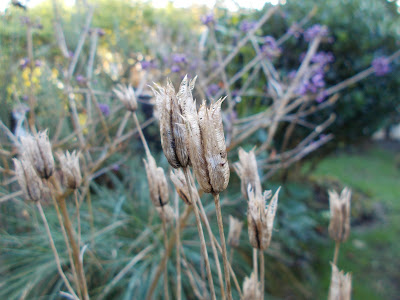 If you want a low maintenance garden, here are some plants you don't need to look after for now, just let them do their thing over winter.
If you want a low maintenance garden, here are some plants you don't need to look after for now, just let them do their thing over winter.
If you want to, you can spend most of November clearing up the garden. Cutting things back when they've finished flowering, tidying up windfalls of fruits and debris that's been blown around, clearing up leaves, the list goes on.
But why make gardening hard work?
I've collected several bags of leaves, to make leaf mould to add as a soil improver, and I've spread the result of last autumn's leaf collection on the beds after planting the tulips, but I haven't removed a single fallen leaf from the borders around my garden. It's nature's way of replenishing the soil.
I leave them where they've fallen if that's around the base of the plants, just keeping them off the crown of anything that's died back, to make sure it doesn't rot. My leaf mould is the product of what's fallen on the paths, or in the lane outside the back gate - a simple ten minute job to collect, bag, moisten and hide until next year.
I've collected several bags of leaves, to make leaf mould to add as a soil improver, and I've spread the result of last autumn's leaf collection on the beds after planting the tulips, but I haven't removed a single fallen leaf from the borders around my garden. It's nature's way of replenishing the soil.
I leave them where they've fallen if that's around the base of the plants, just keeping them off the crown of anything that's died back, to make sure it doesn't rot. My leaf mould is the product of what's fallen on the paths, or in the lane outside the back gate - a simple ten minute job to collect, bag, moisten and hide until next year.
As for the flowers, well there are still plenty around, and plenty of winter flowering species still to come. But many of the summer blooms have faded and you might be tempted to cut them down and compost them.
If they look particularly untidy, or are flopping over and getting in the way then it may be worth it, but in many cases I will be leaving them alone until February, or later.
If they look particularly untidy, or are flopping over and getting in the way then it may be worth it, but in many cases I will be leaving them alone until February, or later.
Even when apparently well past their peak, plants can offer a structural element to the garden, just as the skeletal forms of the trees do higher up. They can be interesting to look at, especially when frosted, and with some fascinating seed heads amongst the myriad of reproductive means developed over millions of years of evolution.
They can be a source of food for wildlife over winter. And they can seed themselves in the ground naturally, adding even more plants to your garden and saving you time and money.
They can be a source of food for wildlife over winter. And they can seed themselves in the ground naturally, adding even more plants to your garden and saving you time and money.
Here are six things I'm going to leave alone for as long as I can:
Sedum spectabile
 |
| Sedum spectabile |
Still brilliantly purple, this Sedum was touched by frost this morning, giving it a light dusting of crystals. Fresh growth is already appearing at the base, but I will leave these flower heads for winter interest unless they collapse to the ground. Until then they will carry on looking good.
Verbena bonariensis
 |
| Verbena bonariensis |
The tall slender stems of Verbena bonariensis catch the autumn light beautifully, and the seeds will fall and grow, meaning I am unlikely to need to plant any more. The pinky purple haze they offer several feet off the ground in summer is almost guaranteed to return if you just let them do their thing. If they pop up where you don't want them just pull them up and replant, but you are unlikely to have a shortage!
Rudbeckia
 |
| Rudbeckia |
There are in fact plenty of flowers still on the rudbeckia but I hope this picture shows that they can be left and enjoyed long after the petals have fallen.
Sedum "Purple Emperor"
 |
| Sedum "Purple Emperor" |
Another Sedum. It probably could benefit from a Chelsea chop as it's got a bit straggly, but I particularly like the ghostly white stems it has developed in the autumn - they are quite eye-catching.
Aquilegia
 |
| Aquilegia |
The seed heads of Aquilegia are worth a closer look. And if you leave them to seed around they will fill your garden with colour in May. They don't come true, so whatever colour they were before they will cross pollinate and generate random colours next year, but again, any that don't suit your plans are easily pulled up, though not as easy to replant as the verbena. If you catch them at the right time, the seed is quite easy to collect, for giving away or saving for later.
Calendula
 |
| Calendula |
This was only here because I left it there to seed itself last year. What beautiful seeds! Just as lovely as the flowers, and I think the birds like these too.
So which plants are you leaving alone to seed around or to enjoy their form in the frost or over winter?